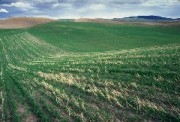| |
|
One of Agriculture's most important jobs is to look for ways to help
keep soil and water from running off a farmer's field. Conserving soil and
water influences the water cycle or hydrologic cycle, which shows how
water moves throughout the atmosphere. When rain and snow fall on the
land, it can soak into the soil, evaporate into the air, or run off into
streams and rivers where it is carried to the ocean. If rain and snow
falls in the ocean it can evaporate into the air right away. Evaporation
from the ocean is the beginning of the water cycle. (See picture below)
The Hydrologic Cycle

In the Pacific Northwest most of the rain falls in western Oregon and
Washington. The Cascade Mountains act as a wall and block most of the rain
from falling in eastern Oregon and Washington. Therefore, these areas east
of the Cascades total only 6 to 24 inches of rain every year.
The time of year that rainfall occurs is also important. We have a
Mediterranean climate which means that most of our rain falls between the
months of September and May. The months of summer (June-August) are very
dry. Since most of our rain comes in the wintertime, it is very hard to
grow crops in the summer without irrigation.
We cannot control when or how much water will fall on our
land. However, our research can help conserve water by changing the soil,
plants, and the type of farming used to grow crops. With basic research we
can use rainfall simulators to learn how water flows on or through the soil,
and how different crops and residues affect water movement. With applied
research we can study and use different farm
equipment to learn how tillage affects the storage of water in a soil
profile. Our research helps farmers find the best way to grow their crops,
given our water environment. We help to keep the soil in farmers fields
and not in the rivers, streams, and oceans.
|
|



 |


